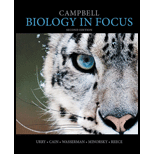
Concept explainers
which of me following characteristics. structures. or processes is common to both bacteria and viruses?
- A.
metabolism - B. ribosomes
- C. genetic material composed of
nucleic acid - D. cell division
Introduction:
Bacteria are single-celled micro-organisms that are present in diverse environments. Most of them are harmless and inhabit the human intestine. Bacterial infections include tuberculosis, strep throat, urinary tract infections, and others. Viruses are smaller in size than bacteria and they require a living host for their survival. Common cold, chicken pox, and herpes are some of the diseases caused by viruses.
Answer to Problem 1TYU
Correct answer:
The property that is common to both viruses and bacteria is that their genetic material is made up of nucleic acids, which are made up of nucleotides and serves as the heredity transferring material in both the organisms. Therefore, option (C) is the correct.
Explanation of Solution
Reason for the correct statement:
Bacteria are independent of other organisms for their growth and survival. Whereas, viruses depend on the host cell for their growth and replication. The genetic material of bacteria floats freely in the cytoplasm of the cell, whereas the genetic material of viruses is covered by a protein coat called capsid.
Option (C) is given as “genetic material is composed of nucleic acids”.
“The genetic material which is composed of nucleic acid is common to both bacteria and viruses” is the right answer.
Hence, option (C) is correct.
Reasons for the incorrect statement:
Option (A) is given as “metabolism”.
Viruses do not have their own metabolic machinery. They depend on the host’s metabolic machinery for their metabolism. However, bacteria have their own metabolic machinery and hence they are able to carry out all their metabolic functions. Hence, it is the wrong answer.
Option (B) is given as “ribosomes”.
Bacteria consist of ribosomes whereas viruses lack ribosomes. Hence, they cannot synthesize proteins and they depend on host cells. Therefore, it is the wrong answer.
Option (D) is given as “cell division”.
The bacterial cell divides by fission. However, viruses depend on the host cell in order to produce multiple copies and the process of assembly also occurs in the host. Hence, it is the wrong answer.
Hence, options (A), (B), and (D) are incorrect.
Like bacteria, viral genetic information is also coded in the form of nucleic acids. Hence, this is the characteristic that is common to both the microbes.
Want to see more full solutions like this?
Chapter 17 Solutions
Campbell Biology in Focus (2nd Edition)
Additional Science Textbook Solutions
Campbell Essential Biology with Physiology (5th Edition)
Principles of Anatomy and Physiology
Human Anatomy & Physiology (11th Edition)
Essentials of Human Anatomy & Physiology (12th Edition)
Laboratory Experiments in Microbiology (12th Edition) (What's New in Microbiology)
- Unlike eukaryotic cells, prokaryotic cells ________. a. have no plasma membrane b. have RNA but not DNA c. have no nucleus d. a and carrow_forwardWhich of these do all prokaryotes and eukaryotes share? a. nuclear envelope b. cell walls c. organelles d. plasma membranearrow_forwardWhich of the following statements is correct? a. Ribosomes are only found in bacteria and archaea. b. Some animal cells are prokaryotic c. Only eukaryotic cells have mitochondria d. The plasma membrane is the outermost boundary of all cells. e. Some cell membranes do not consists of lipids.arrow_forward
- Which of the following is found both in eukaryotic and prokaryotic cells? a. nucleus b. mitochondrion c. vacuole d. ribosomearrow_forwardWhich answer below best describes the cellular location of ActRIIB (Select one)? A. Endoplasmic Reticulum B. Nucleus C. Cell Surface D. Nucleolus E. Cytoplasmarrow_forwardA cell that produces a lot of _________ would have a lot of ribosomes.arrow_forward
- ______ cells lack a membrane-bound nucleus and do not have DNA. a Eukaryotic b Binary c Plasmid d Prokaryoticarrow_forwardThe presence of a membrane-enclosed nucleus is a characteristic of ________. a. prokaryotic cells b. eukaryotic cells c. all cells d. virusesarrow_forwardA prominent difference between prokaryotic and eukaryotic cells is thea. larger size of prokaryotesb. lack of pigmentation in eukaryotesc. presence of a nucleus in eukaryotesd. presence of a cell wall in prokaryotesarrow_forward
- Which of the following is NOT true about the nucleus? It ____. a. contains the DNA b. is covered by a nucleolus c. accommodates cell division d. is enveloped by a membranearrow_forwardJames, a student from anatomy class argued his professor that mature human red blood cells are prokaryotic as they are said to be “anucleated cells”. Can a mature human red blood cells classified as prokaryotic? Support your answer.arrow_forwardIt was once thought that only the nucleus of each cell contained DNA. We now know that DNA is also found in thea. cytoskeleton and the ribosomes.b. prokaryotes and the eukaryotes.c. endoplasmic reticulum and the Golgi bodies.d. mitochondria and the chloroplasts.arrow_forward
 Comprehensive Medical Assisting: Administrative a...NursingISBN:9781305964792Author:Wilburta Q. Lindh, Carol D. Tamparo, Barbara M. Dahl, Julie Morris, Cindy CorreaPublisher:Cengage Learning
Comprehensive Medical Assisting: Administrative a...NursingISBN:9781305964792Author:Wilburta Q. Lindh, Carol D. Tamparo, Barbara M. Dahl, Julie Morris, Cindy CorreaPublisher:Cengage Learning
 Concepts of BiologyBiologyISBN:9781938168116Author:Samantha Fowler, Rebecca Roush, James WisePublisher:OpenStax College
Concepts of BiologyBiologyISBN:9781938168116Author:Samantha Fowler, Rebecca Roush, James WisePublisher:OpenStax College Biology Today and Tomorrow without Physiology (Mi...BiologyISBN:9781305117396Author:Cecie Starr, Christine Evers, Lisa StarrPublisher:Cengage Learning
Biology Today and Tomorrow without Physiology (Mi...BiologyISBN:9781305117396Author:Cecie Starr, Christine Evers, Lisa StarrPublisher:Cengage Learning Biology (MindTap Course List)BiologyISBN:9781337392938Author:Eldra Solomon, Charles Martin, Diana W. Martin, Linda R. BergPublisher:Cengage Learning
Biology (MindTap Course List)BiologyISBN:9781337392938Author:Eldra Solomon, Charles Martin, Diana W. Martin, Linda R. BergPublisher:Cengage Learning




